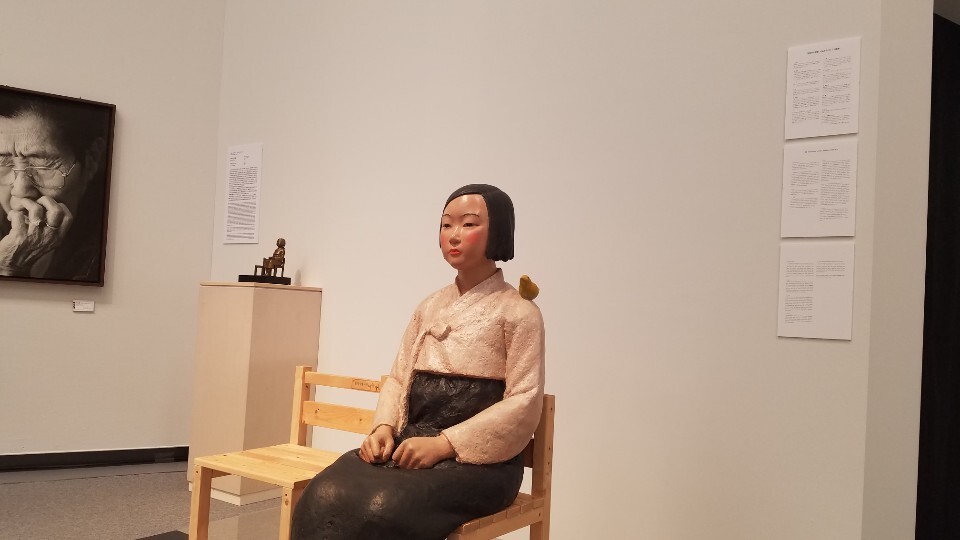hankyoreh
Links to other country sites 다른 나라 사이트 링크
Aichi Triennale artists demand their work to be taken down

After the closure of an exhibition featuring the “Statue of a Girl of Peace” at the Aichi Triennale 2019, Japan’s largest international art festival, some artists from around the world are protesting by calling for the festival to take down their pieces. The statue in question represents the comfort women, a euphemistic term for women forced into sexual servitude for the Japanese army during World War II.
NHK and other Japanese media outlets reported on Aug. 15 that 12 out of 90 teams of artists that submitted works to the Triennale have asked for their works to be removed from exhibitions at the art festival.
On Aug. 10, the Center for Investigative Reporting (CIR), a US-based nonprofit reporting organization, stopped playing an animation inspired by articles written by the organization. A rope now bars the entrance to the space where the CIR’s piece had been displayed. That hall is right next to “After ‘Freedom of Expression?’” the exhibition that showed the comfort woman statue before it was shut down.
Some of the artists that the Triennale organizers had heavily promoted this year have asked for their pieces to be taken down. Among their number is US-based artist Ugo Rondinone, whose installation “Vocabulary of Solitude” appears on the cover of the Triennale’s official guidebook. That installation consists of a number of clown statues in a variety of poses.
In a document sent to the organizers on Aug. 12, Rondinone criticized their decision to halt the “After ‘Freedom of Expression?’” exhibition, asserting that the freedom of expression is an inviolable right.
The Triennale has also been asked to take down “Front Curtain,” a piece that was showcased in its opening ceremony, by the Mexican artist Pia Camil.
Two of the 12 teams in question hail from South Korea (filmmakers Park Chan-kyong and Lim Min-ouk, who asked for their pieces to be taken down on Aug. 3), while the other 10 are artists from Europe, Central America, and South America. Considering the Triennale features 66 teams of artists from overseas, nearly 20% of the international contingent is essentially pulling out.
The controversy began when Hideaki Omura, governor of Aichi Prefecture, shut down the “After ‘Freedom of Expression?’” exhibition just three days after it opened. Omura justified his decision by citing phone calls and emails threatening terrorist attacks on that exhibition, in which the comfort woman statue was displayed. While the pieces are still there, behind a partition in the venue, the entrance is blocked, preventing visitors from viewing them. The members of the exhibition’s executive committee are calling for the festival to reopen the exhibition after beefing up security.
While the Triennale organizers hope to reach an arrangement with the artists from Europe, Central America, and South America so that their pieces can be kept on display, the takedown demands are bound to have an impact.
The growing controversy prompted Hiroki Izuma, a critic and festival advisor, to announce his resignation on Twitter on Aug. 14. Izuma was one of the figures who supported the shutdown, arguing that the comfort woman statue was being “used for political purposes.”
In a related story, Aichi Prefecture announced on Aug. 14 that it had filed police reports in regard to 770 menacing emails sent in about the Triennale. The emails contained threats to “pour gasoline on schools and other structures in the prefecture and burn them down” and to “murder staff.”
By Cho Ki-weon, Tokyo correspondent
Please direct comments or questions to [english@hani.co.kr]

Editorial・opinion
![[Column] Has Korea, too, crossed the Rubicon on China? [Column] Has Korea, too, crossed the Rubicon on China?](https://flexible.img.hani.co.kr/flexible/normal/500/300/imgdb/original/2024/0419/9317135153409185.jpg) [Column] Has Korea, too, crossed the Rubicon on China?
[Column] Has Korea, too, crossed the Rubicon on China?![[Correspondent’s column] In Japan’s alliance with US, echoes of its past alliances with UK [Correspondent’s column] In Japan’s alliance with US, echoes of its past alliances with UK](https://flexible.img.hani.co.kr/flexible/normal/500/300/imgdb/original/2024/0419/2317135166563519.jpg) [Correspondent’s column] In Japan’s alliance with US, echoes of its past alliances with UK
[Correspondent’s column] In Japan’s alliance with US, echoes of its past alliances with UK- [Editorial] Does Yoon think the Korean public is wrong?
- [Editorial] As it bolsters its alliance with US, Japan must be accountable for past
- [Guest essay] Amending the Constitution is Yoon’s key to leaving office in public’s good graces
- [Editorial] 10 years on, lessons of Sewol tragedy must never be forgotten
- [Column] A death blow to Korea’s prosecutor politics
- [Correspondent’s column] The US and the end of Japanese pacifism
- [Guest essay] How Korea turned its trainee doctors into monsters
- [Guest essay] As someone who helped forge Seoul-Moscow ties, their status today troubles me
Most viewed articles
- 1[Column] The clock is ticking for Korea’s first lady
- 2Hong Se-hwa, voice for tolerance whose memoir of exile touched a chord, dies at 76
- 3After 2 months of delayed, denied medical care, Koreans worry worst may be yet to come
- 4[Column] Has Korea, too, crossed the Rubicon on China?
- 5US overtakes China as Korea’s top export market, prompting trade sanction jitters
- 6Samsung barricades office as unionized workers strike for better conditions
- 7All eyes on Xiaomi after it pulls off EV that Apple couldn’t
- 8[Correspondent’s column] In Japan’s alliance with US, echoes of its past alliances with UK
- 975% of younger S. Koreans want to leave country
- 10[Correspondent’s column] The US and the end of Japanese pacifism